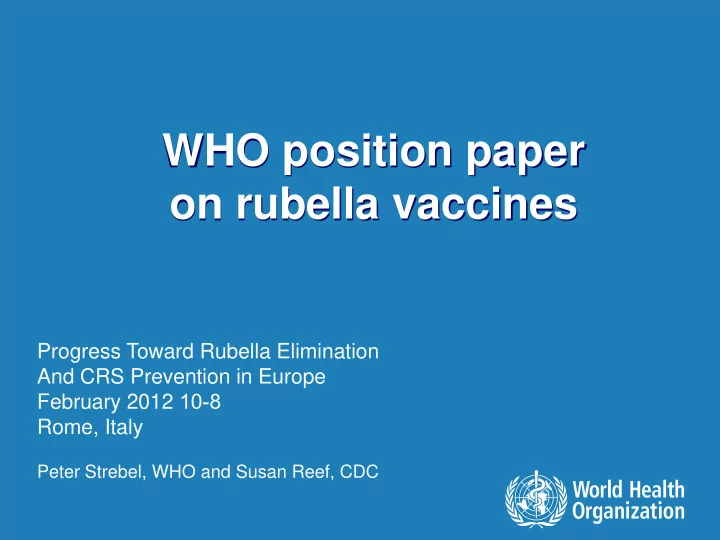

WHO position paper on rubella vaccines Progress Toward Rubella Elimination And CRS Prevention in Europe 10 - 8 February 2012 Rome, Italy Peter Strebel, WHO and Susan Reef, CDC
Rubella Vaccines WHO Position Paper Epidemiology Virus and rubella/CRS Vaccines Immunogenicity Vaccine effectiveness Precautions and contraindications Cost effectiveness Vaccination strategies Weekly Epidemiological Record, 15 July 2011, 86, 301 – 316
Vaccination strategies Purpose: – The primary purpose is to prevent the occurrence of congenital rubella infection including CRS Strategies: 1. Focus is on reducing CRS by immunizing adolescent girls and/or women of childbearing age 2. Aims at interrupting transmission and thereby eliminating rubella as well as CRS
1: Reducing CRS only For CRS reduction alone, adolescent and adult females should be vaccinated through either routine services or SIAs. This option will provide direct protection to women of childbearing age; however, the impact is limited by the coverage achieved and the age groups targeted. In the absence of a programme that vaccinates infants and young children, rubella will continue to circulate , resulting in ongoing exposure of pregnant women and the associated risk of CRS.
2: Rubella elimination For the elimination of rubella (and thereby CRS), the preferred approach is to begin with MR or MMR vaccine in a campaign targeting a wide range of ages, immediately followed by introduction of MR or MMR vaccine into the routine childhood programme. All subsequent follow-up campaigns should use MR or MMR vaccine. In addition, countries should make efforts to reach women of childbearing age by immunizing adolescent girls or women of childbearing age, or both, either through routine services or mass campaigns.
Synergy with measles programmes Measles-vaccine delivery strategies provide an opportunity for synergy and a platform for advancing rubella and CRS elimination. All countries that are providing 2 doses of measles vaccine using routine immunization or supplementary immunization activities (SIAs), should consider including RCVs in their immunization programme. Cost-benefit studies of rubella vaccination have shown that benefits outweigh costs and that rubella vaccination is economically justified, particularly when combined with measles vaccine
Importance of high vaccination coverage Sustained low coverage of rubella immunization in infants and young children can result in increased susceptibility among women that may increase the risk of CRS above levels during the prevaccine era (“paradoxical effect”). Hence, countries should achieve and maintain immunization coverage of ≥80% with at least one dose of an RCV delivered through routine services or regular SIAs.
Countries planning to introduce RCV Should review the epidemiology of rubella and assess the burden CRS Establish rubella/CRS prevention as a public health priority Depending on the burden of CRS and available resources, countries should determine their goal and time frame for achieving it Introduction of RCV implies a long-term commitment to achieving and maintaining sufficient immunization coverage to ensure sustained reduction in CRS incidence. Strong political commitment to the elimination of rubella and CRS, and sustainable financing for vaccination and surveillance activities must be in place before initiating rubella vaccination.
Field and laboratory surveillance Should be fully integrated with measles in a single surveillance system Need to document the impact of rubella vaccination : – laboratory-supported surveillance for rubella and CRS surveillance – molecular epidemiology – monitoring of vaccine coverage – monitoring population immunity using seroprevalence surveys where appropriate.
Country Examples Eastern Mediterranean Region
Tunisia
Rubella vaccination in Tunisia Goal: CRS reduction 2005: MR for Girls age 12y (90%) 2005: Catch-up campaign for girls 13-18y (>90%) Postpartum vaccination (19%) CRS surveillance in 3 sentinel sites
Reported Rubella Cases, 1999-2011 800 700 Reported Rubella Cases 600 MR for girls age 12y 500 MR catch-up campaign for girls 13-18y 400 55% <12y 300 21% 12-20y (88% male) 50 hospitalisations 200 3 deaths 4 CRS to date 100 0 1999 2000 2001 2002 2003 2004 2005 2006 2007 2008 2009 2010 2011 PNV / DSSB MSP Tunisie
Egypt
Rubella vaccination in Egypt Rubella vaccine was introduced in MMR vaccine in 1999 at the age of 18 months In 2008, vaccination schedule modified to accelerate measles and rubella elimination and additional dose of MMR at 12 months Coverage by the 2 doses >95% Rubella was diagnosed clinically before introduction of laboratory confirmation in 2002
Reported Rubella Cases in Egypt (1998 – 2011) no of cases 12000 11689 10000 MR Campaign Phase 1:10y -19y 8000 Phase 2: 2y -10y MMR Laboratory Confirmation introduction at 6000 2002 18m, 1999 4000 2587 2000 1097 274 261 520 12 21 24 9 25 12 0 19 29 1998 1999 2000 2001 2002 2003 2004 2005 2006 2007 2008 2009 2010 2011
Oman
Rubella vaccination in Oman 1994 MR mass campaign, 15m – 18y (94%) 1994 MR introduced in routine at 15m (>95%) 1997 MMR introduced at 15m (>95%) 2001 Post-partum vaccination
Reported rubella cases and routine infant vaccine coverage, Oman 1993-2009 Catch-up, 1994 15m-18 yrs Switch to MR (94%) MMR 15 m Vaccine, 1997 Post-partum Intro. vaccination of MR @15 m Vaccine, 1994 CRS cases: 47 2 3 1
Summary WHO Position Paper (2011): – In light of the remaining global burden of CRS and proven efficacy and safety of RCVs, WHO recommends that countries take the opportunity offered by accelerated measles control and elimination activities to introduce RCVs. Requirement is ability to achieve coverage >80% through routine services or in campaigns Preferred approach is a mass campaign for children 9m- 14y together with introduction in routine Country examples support this approach
Acknowledgements SAGE Working Group on Rubella Vaccines: – Helen Rees (Chair) – Jon Abramson – Hyam Bashour – Malik Peiris – Oyewale Tomori – Susan Reef – Kari Johansen – Karen Lewis-Bell – Aiqiang Xu – Emilia Vynnycky – Liliane Grangeot-Keros
Recommend
More recommend